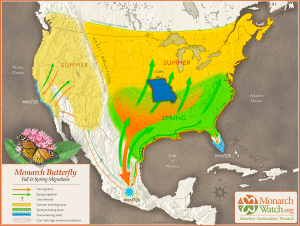The eastern migratory population of monarchs undertakes what is arguably the most dramatic example of insect migration known. Every year, three to five generations of monarch butterflies are needed to successfully complete their migration efforts spanning Mexico, United States and Canada and traverses thousands of miles.
Sadly, in recent decades, this migratory population has declined by more than 80% due to extensive loss of habitat throughout their breeding grounds and migratory path due to land-use changes[1] and/or untimely mowing or pesticide applications, as well as illegal logging, forest degradation, and harsh winter storms at their overwintering lands in Mexico. Monarch population size is assessed by measuring the total area occupied by monarch colonies at their overwintering site in Mexico.

Figure 1
Unfortunately, the most recent overwintering season (2022-2023) for the eastern migratory monarchs’ population saw a 22% reduction in size (Figure 1 above), occupying only 2.21 hectares (5.5 acres). For the monarchs’ population to be considered stable and sustainable, it needs to consistently occupy at least 6 hectares (15 acres).
Missouri and Monarchs
Missouri’s geographical location is situated precisely in the middle of the monarch’s migration corridor, which also serves as their breeding grounds, and is host to more than one generation of monarchs each year, making Missouri’s habitat essential to the monarch population. (Figure 2). In the fall, millions of monarch butterflies travel through Missouri, feeding on available nectar from native plants, fueling their migration to their overwintering grounds in central Mexico. Then, as spring arrives and temperatures warm, monarchs begin their return journey north to their breeding range, once again gracing Missouri with their iconic beauty. This time, however, the monarchs are in search of milkweed to lay their eggs, giving birth to the subsequent generations of monarchs, which will continue their renowned migration.
While the decline in various native species of milkweed is extremely troublesome as they are the monarch’s host plant[2]; the loss of nectar resources further complicates the monarchs’ struggle since the final migratory generation born each year requires these resources to fuel the last leg of their migration flight to their overwintering grounds in Mexico. But you can help!
Missouri has committed to establishing 385,000 acres of additional pollinator habitat. To accomplish this goal, combined and coordinated conservation efforts between conservation organizations, state and local agencies, NGOs, and private landowners are needed. Continued investment and coordinated efforts for this migratory species is needed for a successful outcome and to ensure future generations will be able to witness the monarchs’ magnificent migration.
Whether you have a small balcony, suburban backyard, or several acres; you can create the much needed habitat for monarch butterflies. Check out our Resources section for information on how to create monarch and pollinator habitat regardless of how much space you have.
[1] Land-use changes consist of commercial, residential, and agricultural development or conversion.
[2] The plants monarch butterflies lay their eggs and the only plants monarch caterpillars eat.

